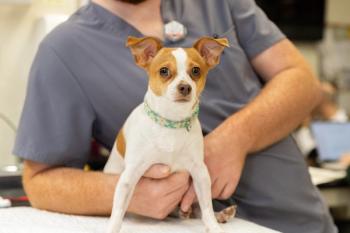
Assessment and basic care of emergency patients (Proceedings)
When a patient first arrives we have all been taught the ABCs of emergency care. We know that the assurance of a clear airway is paramount and the first thing we should all do, and then we move one to B and assure breathing is adequate. Then we move on to C (for cardiovascular) and assess and ensure the heart is pumping and pumping adequately... This process is termed vertical resuscitation and is a "step by step" process that is completed in a "priority of need" sequence.
When a patient first arrives we have all been taught the ABCs of emergency care. We know that the assurance of a clear airway is paramount and the first thing we should all do, and then we move one to B and assure breathing is adequate. Then we move on to C (for cardiovascular) and assess and ensure the heart is pumping and pumping adequately... This process is termed vertical resuscitation and is a "step by step" process that is completed in a "priority of need" sequence. There is absolutely nothing wrong with this approach and is still the gold standard in the "on-arrival resuscitation" of the critical patient. However, I would like to introduce to you a process called "horizontal resuscitation" for the "on arrival immediate care of the critical patient. This method approaches ALL the "ABCs of the critical patient at the same time or nearly at the same time. This, of course, requires a team of at least 2-3 so that simultaneous assessments and treatments of the various areas can occur. Simultaneous assessments and treatments of the ABCDE areas of emergency concerns are then accomplished with the protocol below (Table 1)
Table 1. Horizontal resuscitation of the critical patient on arrival
A. Open the airway
Extending the head and neck if needed, providing a tracheotomy or cricothyroidotomy if needed AS JET – BLOW-BY OXYGEN IS DIRECTED TO THE PATIANT'S NOSE OR MOUTH; intubating using succinylcholine HCl (0.1 mg/kg IV, IM if can't get an IV established with mini-cutdown or rapid IO needle placement...begin bag-valve mask ventilation as the tracheotomy or cricothyroidotomy and ET tube is being placed or as the succinylcholine istaking effect. Immediately follow with acepromazine 0.01 mg/kg, butorphenol 0.1 mg/kg, and ketamine 1 mg/kg as a mixture with all three in the same syringe, given IM, IV, IO.
Do whatever it takes to get the airway clear so breaths can be given...
Example: Boston Terrier with torn trachea example as described above = cardiac arrest in radiology brought to anesthesia –prep room, BVM w/ 100% O2,. No pulse, Chest Compressions initially then intubated, checked for bilateral lung sounds = none = but O2 going in easily.....severe tracheal tear supposed = cervical approach found trachea OK, parasternotomy found trachea pulled apart cranial to heart = elevated distal end of trachea and intubated, direct cardiac massage.. heart responded began beating slowly = gave atropine and 0.01 ml/kg epinephrine and responded very well. patient began waking up (good sign. Started isoflurane and gave oxymorphone 0.03 ml/kg and ace to color(.1 mg) and continued PPV and observation , ECG, Doppler flow and BP with chest covered while went to discuss case w/owner...... The owner was told of the crisis that occurred and approved the next step (see D)
B. Ensure adequate ventilation
(providing Bag Valve Mask Ventilation [Galls 1-800-854-2706] and use of a PEEP valve if needed (pulmonary pathology believed present) Ambu. Attach to oxygen source at 5, 10,15 L/min for infant, pediatric adult resuscitator bags. Alternative = Anesthetic machine BUT you have to play with pop-off valve and this distracts you; A suggestion = use the machine as oxygen source by inserting a Y connector in the line going to the circuit, clamping off the section then going to the circuit then
C. Control hemorrhage with immobilization
(forced; taped to board with towels and duct tape) with the board made of plastic, cardboard, wood and applying pressure (direct) and using pressure points (brachial, femoral, other) and applying a counterpressure dressing , torso wrap, and
C2. Control pain and hypertension with medication
(ketamine 1-2 mg/kg, butorphenol 0.1-.2 mg/kg, acepromazine 0.01-02 mg/kg all in same syringe giving IV or deep IM in epaxial muscle. IF NOT DONE ALREADY. ¼- ½ mcg/kg metomidine can also be used very effectively. Do not give any NSAIDs at this juncture as they help induce renal compromize and failure
C3. Control (overcome) significant hypo-tension-perfusion
(by providing volume replacement as required, and support of the cardiovascular system (use Doppler Blood Flow Detector [ Ultrasonic Blood Flow Detector Model 811-B, Parks Medical Electronics, Inc., 19460 S W Shaw, Aloha, OR 97007, 1-800-547-6427 (for flow and pressure monitoring early) – tape the probe onto the foot at the location of the palmar arterial arch middle of depression on palmar side of the paw just proximal to the metacarpal pad; Other locations: eye, esophagus (probe taped to an esophageal stethoscope and placed so it is laying over the heart).
In extremis give 0.1 ml epinephrine per 10 lb body wt.. IV or IO or double dose and given IT by injection or better yet, place in the hypertonic saline and hetastarch mixture to effect until flows improved to a "swish, swish that sounds adequate" or a BP measured by cuff of adequate size of 50-60 mm Hg systolic. Don't overshoot if possible; Give hypertonic saline and hetastarch mixture at 1 ml of 23% and 3 ml of 6% hetastarch per kg body weight or substitute the hetastarch with a similar colloid such as dextran 70, or gelatin per 1-2 kg body weight. Monitor effect which requires a few minutes to see full effect. Repeat every 3-5 minutes until BP is effective enough (~ 60 mmHg systolic in most cases)
Recent experience with 25% albumin (diluted with 6% hetastarch) as "the colloid" for shock therapy has been very positive = giving like the hetastarch alone with the hypertonic saline, to effect. For patients with very low plasma total protein or serum albumin levels the 25% human albumin should be used to increase albumin levels, given slowly if flow and BP is adequate to bring PTP and albumin to 4.5 and 2.0 respectively.
Example: Gus, lab w/ severe peritonitis from intestinal anastomosis leak...a/d in the abdomen, semiconscious, Doppler flow very poor, BP 30, dehydrated, TPP 2.2, Albumin 0.6 = resuscitated with oxygen. Hypertonic saline 1 ml, with hetastarch 3 ml/kg followed by replenishment of the estimated total body albumin deficit (3.0 - alb level = deficit in g/dl and the albumin compartment estimated in dogs of 100 -110 ml/kg, and cats of 70 ml/kg... Gus at 25 Kg ~ 110 × 25 = 2750/ 100 = 27.5 × (3-0.6 = 2.4) = 66 grams... to be given over 24 hrs (but in this case with severe hypoperfusion 4-5 ml (25%) /kg can be given every 30 minutes with crystalloid support as well (8 – 10 ml/kg until flows are good and pressures are at least 50 to 60 mm Hg)
D. Correct anatomical defects caused by the injury that affect function
(e.g., repairing the ruptured urinary bladder) before its consequences impart serious life-or limb (locomotion) threatening complications. The final goal is to have a comfortable and functional pet return to their owner. The example introduced above (Boston Terrier with a torn intrathoracic trachea (cause undetermined but head caught in the fence and panic pulling to get out was believed possible) is continued: The dog was taken to surgery where the trachea was rebuilt. Several rings that were pulled apart were removed and the trachea was anastomosed using 3-0 polypropylene on a swaged on thin GI taper-needle. It was a difficult surgery but it was accomplished successfully. A nasotracheal catheter was placed as the ET tube was removed as the dog had some pulmonary edema (believed to be centroneurogenic in origin. The edema resolved a completed recovery ensured!!
D2. Perform diagnostics as needed
This often includes radiographs (trauma films) and stat labs (PCV, TS, Azo, Glucose, Lactate, Chemistries, Lytes, Venous O2, CO2, Base deficit,
Quick look ultrasound (FAST = Focused abdominal –sound for trauma). The lateral radiograph is frequently what is obtained first but in some cases the US is done first.
E. Everything else
Providing supportive care (pain control, anxiety control, nutritional support, respiratory and physical therapy support as needed very early to prevent hypoglycemia yet not so aggressive to cause hyperglycemia. Draw blood for blood glucose and lactate; give 25% glucose IV until blood glucose is near or slightly above normal. Consider oral 25% glucose 0.1-0.3 ml/kg as gets absorbed through membranes.
Pain and anxiety control = K A B (ketamine 1-4 mg/kg, acepromazine 0.01-0.04 mg/kg, Butorphenol 0.1-0.4 mg/kg = given IM (higher doses or IV lower doses. Can also use lidocaine as a local or general analgesic and is also a membrane stabilizer. 1-2 mg/kg then 50 mcg/kg/min; morphine at 0.1 mg/kg frequently use this drug along with acepromazine (Norman Shumway, MD, PhD Stanford University Medical School used the principle of vasodilatation and no pain with mean pressures of 30 and was very successful with the cardiac cases that required surgery...flow much more important than pressure...Q proportional to r (4th power) = increased Functional Capillary Density = better tissue perfusion even though blood pressure want down
Nutritional Support = feed 20% glucose and water with glutamine added (1000 mg/ cup of the glucose and water) orally as soon as comfortably possible. Placement of a nasoesophageal or nasogastric feeding tube has been very beneficial. Then the mixture is "trickled" in over hours. Begin with MICROENTERAL nutrition at 0.1 ml/kg/hr and gradually increase the amount every few hours. Devey JJ, Crowe DT, Microenteral Nutrition in Current Veterinary Therapy XIII: Gradually introduce solid food as a gruel. Feed the gut and prevent translocation and stimulate the production of secretory IGG and IGM, MALT
Respiratory Support = encourage deep breathing and good tracheal toilet clearing ; coupage, postural drainage, moving also prevents PE and deep vein thrombosis
Physical Therapy Support = Encourage the pet to begin walking as soon as possible. This prevent deep vein thrombosis and the likelihood of throwing a clot. This also helps send them home earlier.
Triple threat antibiotics: (TAM) Ticarcillin, Amoxicillin, Metonidazole very safe choice!
Provision of sufficient oxygen and glucose to tissues in as short of time possible is the mandatory
Many factors affect oxygen delivery to the cells; however, in general terms O2 delivery depends on the following:
1. O2 being delivered to the alveoli, effective gas exchange,
2. The presence of sufficient hemoglobin to carry the O2,
3. Adequate cardiac output, determined by adequate circulating blood volume, cardiac muscle strength, vascular tone and heart rate producing adequate macrocirculatory flow (through arteries, arterioles, venules and veins).
4. Adequate microcirculatory (capillary) flow through the tissues.
"High Priority Resuscitation" that is resuscitation issues involving the critical emergency patient that can not wait which MUST be addressed immediately upon arrival are those aimed at maximizing oxygen delivery. The treatment must be appropriate and must be provided in a timely manner.
Gut Resuscitation - a goal
Research has shown that if cellular hypoxia to the gastrointestinal tract in dogs continues beyond an hour even though global resuscitation appears adequate death from organ dysfunction and sepsis from gastrointestinal bacterial translocation and endotoxin absorption across the gut wall will likely occur a day to several days later (Shoemaker). Irreversible cellular apoptosis (programmed cellular death) may also occur as an aftermath of the cellular stresses secondary to the global gut effects of the injury. The GI tract must be supported with adequate flow. If the peripheral limbs have poor flow the gut will have poor flow. Pale mucus membranes = pale gut and poor flow. A good resuscitation mixture is oxygen blow-by then the infusion if hypertonic saline and a colloid. (hypertonic saline and hetastarch at a 1 to 3 ratio 1 ml 23% NaCl mixed with 3 ml of 6% Hetastarch and given IV as a mixture (dose = up to 5 ml per Kg patient body weight). This decreases ICAM and other adhesion reactions (platelets and red cells with activated WBCs) to cause microemboli.
Therefore successful care reiterated requires timely and accurate patient examination, assessment and treatment in proper sequence according to physiologic priorities. Since all three of these components occur simultaneously in the injured, all three are included in the decision making that must performed accurately and in as short of times as possible. One thing that cannot be bought is time. Therefore the decisions not only have to be accurate but also with expedience.
Protocol – Initial Management of Arriving Emergency Patients
Reception does initial assessment and notes patient on arrival and has ability to notify team immediately if pet is obviously "IN TROUBLE" . Patients may be ushered immediately to the treatment room OR pages triage nurse* to front desk. Also receptionist notes time on "Arrival Sheet" and may enter initial presentation findings on the communications sheet.
Triage is performed within 1 minute of arrival by a qualified professional (QP)*
*QP = someone with the experience and training to assess the patient and owner regarding the immediacy of medial care need. Technical support personnel (RVT, VT, Assistant VT and Reception Staff and Cadets (with training) qualify. Alert treatment area that an owner may be coming back as a common courtesy. Then the triage person....
1. Asks history CC
2. Assesses LOC (level of consciousness), respiratory effort, membrane color
Places pet into one of three categories based on the quick exam and history (Triage) :
• Immediate Life –Threatening (Red)
• Urgent (Blue or Yellow)
• Not Currently Urgent – Stable (green)
• DOA - (Black)
If condition is RED (immediately life threatening) (critical)
Transfer patient immediately to READY AREA
1. Assess owner and if possible have the accompany pet, showing care. In many cases the owner will arrive with the pet in their arms or in a carrier and appear panicky of very upset. Showing kindness and making an effort to calm them will be so important to them. Ask them if its OK for them to follow you to the ready (trauma) resuscitation area.
2. If DVM not on the floor PAGE/CALL them for immediate response
3. Owners can assist w/ transfer, carry if believed can safely be done
4. Owners with pets in arms – have them continue to carry to ready area table
a. Recommended to take owners w/pet to allow seeing where pet is going
b. Owners may assist with transport, holding, talking to pet, etc.**
5. For pts unresponsive ask for permission to start resuscitation and with OK start RESUSCITIATION (BASED ON ABCs)
Techs only begin basic CPCR. Advanced CPCR to be done when guided by DVM present \ in OR
6. For pts semicomatose ask owner for permission to start oxygen and an "IV" and with their OK....
7. Begin flow by oxygen (2-6 L/M); OK to give owners task (optional)
8. Ask owners history as they are holding and present in the area.
9. Clip the vein (do facilitative maneuver and place IV if training present)
10. Start Normosol-R at KVO rate (unless in clinical shock then start hypertonic saline 2-3 ml/kg IV bouls over a few minutes [do noy slam] and hetastarch 2-3 ml/kg with this again as a bolus over a few minutes
11. Look for source of fluid, blood loss (external bleeding, internal bleeding, severe diarrhea, distrubutive, GDV, bowel volvulus, and begin therapy as needed: stop hemorrhage; decompress stomach, to OR ect.
Reassess, exam and history, consider basic labs, basic rads, US,: if you do not look you will not find! Reexamine!!
Newsletter
From exam room tips to practice management insights, get trusted veterinary news delivered straight to your inbox—subscribe to dvm360.





